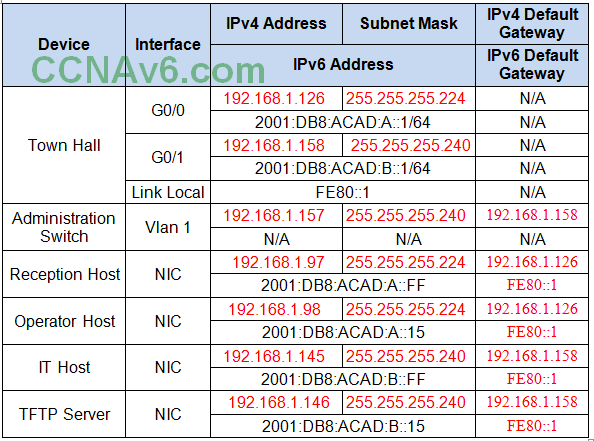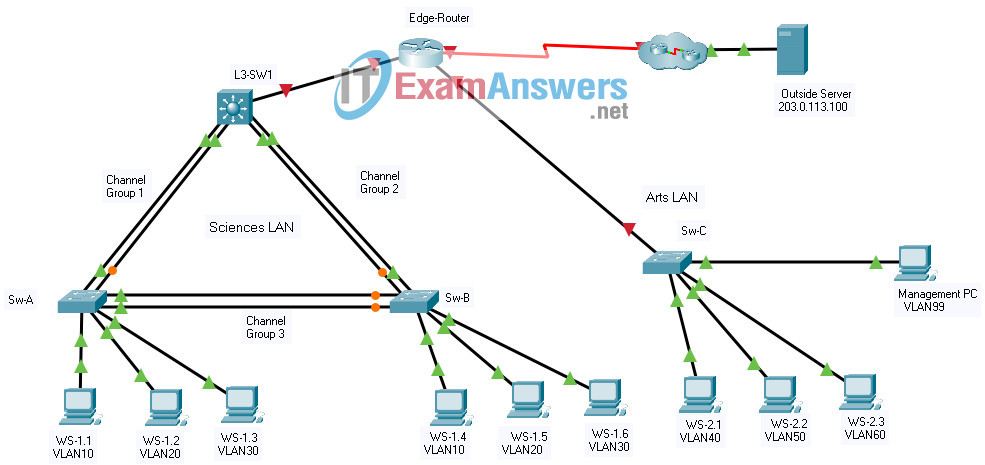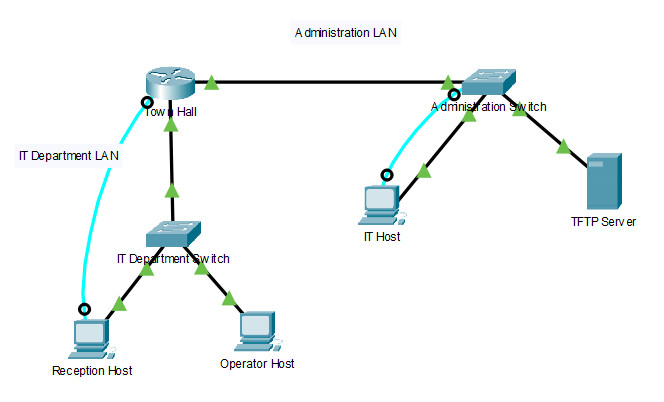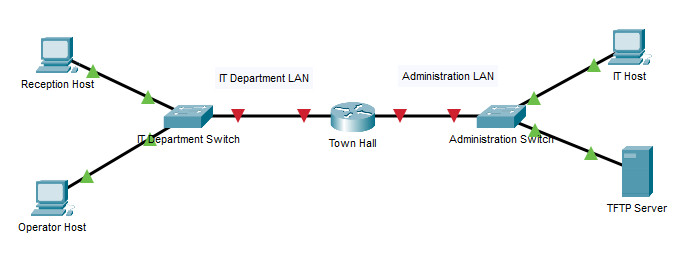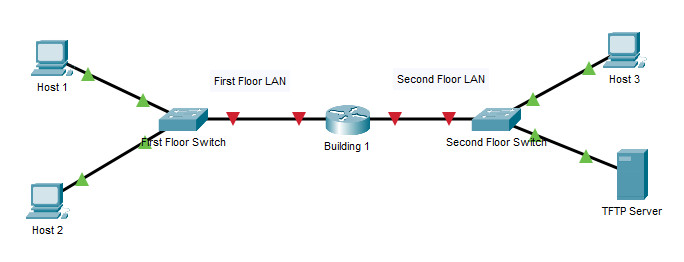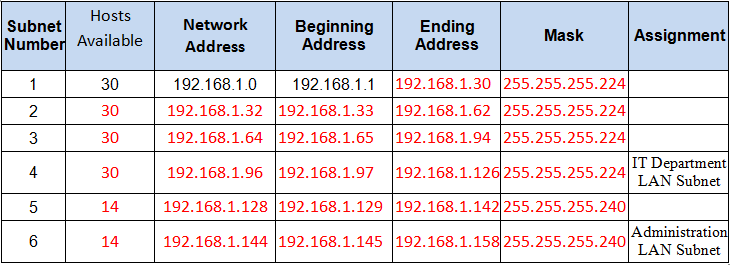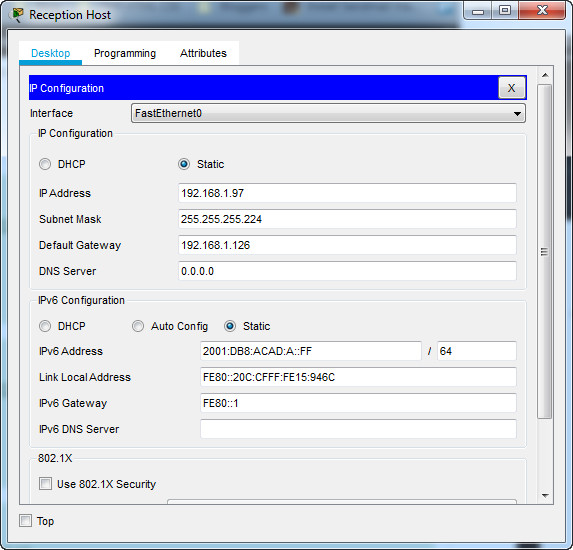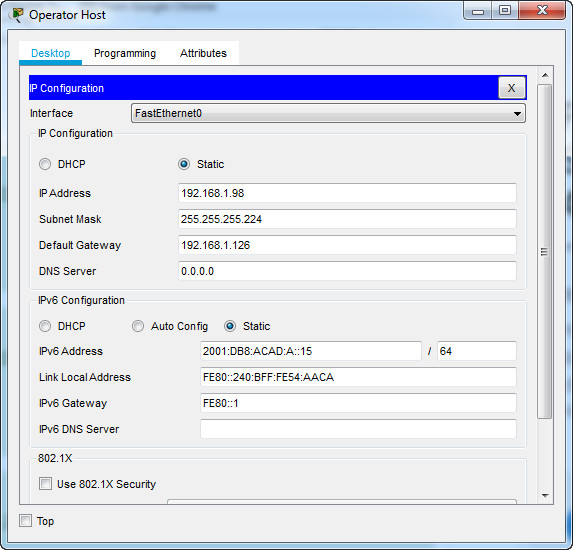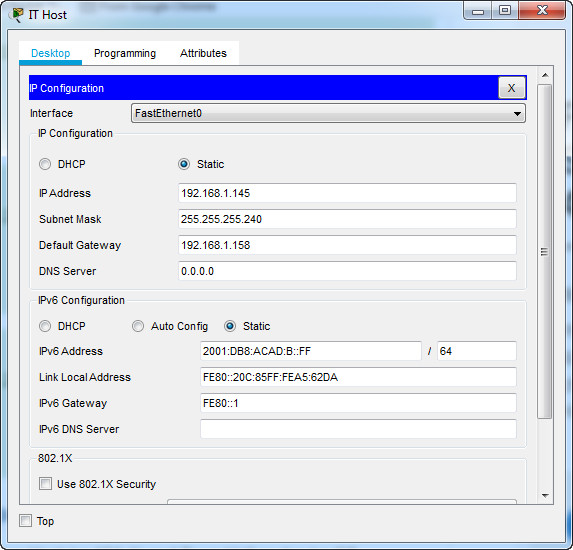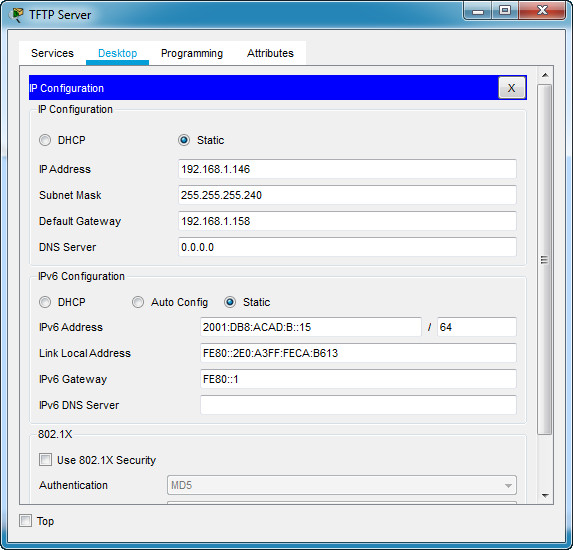itn оценка практических навыков packet tracer ptsa
CCNA 1 Introduction To Networks Ver 6.0 – ITN Practice Skills Assessment Packet Tracer Exam Answers
CCNA 1 Practice Skills Assessment Packet Tracer Exam Answers
[tabs][tab title=”TYPE A”]
CCNA Routing and Switching Introduction to Networks
ITN Practice Skills Assessment – Packet Tracer Type A
A few things to keep in mind while completing this activity:
1. Do not use the browser Back button or close or reload any exam windows during the exam.
2. Do not close Packet Tracer when you are done. It will close automatically.
3. Click the Submit Assessment button in the browser window to submit your work.
Introduction
In this assessment, you will configure devices in an IPv4/IPv6 network. For the sake of time, you will not be asked to perform all configurations on all network devices as you may be required to do in a real network or other assessment. Instead, you will use the skills and knowledge that you have learned in the labs in this course to configure the Building 1 router. In addition, you will address the hosts on two LANs with IPv4 and IPv6 addresses, activate and address the management interface of the Second Floor Switch, and back up a device configuration to a TFTP server.
You will receive one of several topologies.
You are not required to configure the First Floor Switch, and you will not be able to access it in this practice skills assessment activity.
All IOS device configurations should be completed from a direct terminal connection to the device console. In addition, many values that are required to complete the configurations have not been given to you. In those cases, create the values that you need to complete the requirements. For values that have been supplied to you, they must be entered exactly as they appear in order for you to get full credit for your configuration.
You will practice and be assessed on the following skills:
• Configuration of initial IOS device settings
• Design and calculation of IPv4 addressing
• Configuration of IOS device interfaces including IPv4 and IPv6 addressing when appropriate
• Addressing of network hosts with IPv4 and IPv6 addresses
• Enhancing device security, including configuration of the secure transport protocol for remote device configuration
• Configuration of a switch management interface
Requirements by device:
Building 1 router:
• Configuration of initial router settings
• Interface configuration and IPv4 and IPv6 addressing
• Device security enhancement or device hardening
• Secure transport for remote configuration connections as covered in the labs
• Backup of the configuration file to a TFTP server
Second Floor Switch:
• Enabling basic remote management by Telnet
PC and Server hosts:
• IPv4 full addressing
• IPv6 addressing
Addressing Table
Instructions
Step 1: Determine the IP Addressing Scheme.
Design an IPv4 addressing scheme and complete the Addressing Table based on the following requirements. Use the table to help you organize your work. 
a. Subnet the 192.168.1.0/24 network to provide 30 host addresses per subnet while wasting the fewest addresses.
b. Assign the fourth subnet to the First Floor LAN.
c. Assign the last network host address (the highest) in this subnet to the G0/0 interface on Building 1. ( 192.168.1.126 )
d. Starting with the fifth subnet, subnet the network again so that the new subnets will provide 14 host addresses per subnet while wasting the fewest addresses.
e. Assign the second of these new 14-host subnets to the Second Floor LAN.
f. Assign the last network host address (the highest) in the Second Floor LAN subnet to the G0/1 interface of the Building 1 router. ( 192.168.1.158 )
g. Assign the second to the last address (the second highest) in this subnet to the VLAN 1 interface of the Second Floor Switch. ( 192.168.1.157 )
h. Configure addresses on the hosts using any of the remaining addresses in their respective subnets.
Step 2: Configure the Building 1 Router.
a. Configure the Building 1 router with all initial configurations that you have learned in the course so far:
• Configure the router hostname: Middle
• Protect device configurations from unauthorized access with the encrypted privileged exec password.
• Secure all access lines into the router using methods covered in the course and labs.
• Require newly-entered passwords must have a minimum length of 10 characters.
• Prevent all passwords from being viewed in clear text in device configuration files.
• Configure the router to only accept in-band management connections over the protocol that is more secure than Telnet, as was done in the labs. Use the value 1024 for encryption key strength.
• Configure local user authentication for in-band management connections. Create a user with the name netadmin and a secret password of Cisco_CCNA5 Give the user the highest administrative privileges. Your answer must match these values exactly.
b. Configure the two Gigabit Ethernet interfaces using the IPv4 addressing values you calculated and the IPv6 values provided in the addressing table.
• Reconfigure the link local addresses to the value shown in the table.
• Document the interfaces in the configuration file.
Step 3: Configure the Second Floor Switch.
Configure Second Floor Switch for remote management over Telnet.
Step 4: Configure and Verify Host Addressing.
a. Use the IPv4 addressing from Step 1 and the IPv6 addressing values provided in the addressing table to configure all host PCs with the correct addressing.
b. Use the router interface link-local address as the IPv6 default gateways on the hosts.
Step 5: Backup the Configuration of the Building 1 Router to TFTP.
a. Complete the configuration of the TFTP server using the IPv4 addressing values from Step 1 and the values in the addressing table.
b. Backup the running configuration of Building 1 to the TFTP Server. Use the default file name.
Answers
Building 1 Router
Use line console to connect Host 1 and Building 1 Router. On Host 1, go to “Desktop Tab” –> choice “Terminal”
Building 1 Router
Use line console to connect Host 3 and Second Floor Switch. On Host 3, go to “Desktop Tab” –> choice “Terminal”
[/tab]
[tab title=”TYPE B”]
CCNA Routing and Switching Introduction to Networks
ITN Practice Skills Assessment – Packet Tracer Type B

A few things to keep in mind while completing this activity:
1. Do not use the browser Back button or close or reload any exam windows during the exam.
2. Do not close Packet Tracer when you are done. It will close automatically.
3. Click the Submit Assessment button in the browser window to submit your work.
Introduction
In this assessment, you will configure devices in an IPv4/IPv6 network. For the sake of time, you will not be asked to perform all configurations on all network devices as you may be required to do in a real network or other assessment. Instead, you will use the skills and knowledge that you have learned in the labs in this course to configure the Town Hall router (or CS Department Router). In addition, you will address the hosts on two LANs with IPv4 and IPv6 addresses, activate and address the management interface of the Administration Switch (or LAB 214-A Switch), and back up a device configuration to a TFTP server.
You will receive one of several topologies.
You are not required to configure the IT Department Switch, and you will not be able to access it in this practice skills assessment activity.
All IOS device configurations should be completed from a direct terminal connection to the device console. In addition, many values that are required to complete the configurations have not been given to you. In those cases, create the values that you need to complete the requirements. For values that have been supplied to you, they must be entered exactly as they appear in order for you to get full credit for your configuration.
You will practice and be assessed on the following skills:
• Configuration of initial IOS device settings
• Design and calculation of IPv4 addressing
• Configuration of IOS device interfaces including IPv4 and IPv6 addressing when appropriate
• Addressing of network hosts with IPv4 and IPv6 addresses
• Enhancing device security, including configuration of the secure transport protocol for remote device configuration
• Configuration of a switch management interface
Requirements by device:
Town Hall router (or CS Department Router):
• Configuration of initial router settings
• Interface configuration and IPv4 and IPv6 addressing
• Device security enhancement or device hardening
• Secure transport for remote configuration connections as covered in the labs
• Backup of the configuration file to a TFTP server
Administration Switch (or LAB 214-A Switch):
• Enabling basic remote management by Telnet
PC and Server hosts:
• IPv4 full addressing
• IPv6 addressing
Addressing Table
Instructions
Step 1: Determine the IP Addressing Scheme.
Step 2: Configure the Town Hall router (or CS Department Router).
a. Configure the Town Hall router (or CS Department Router) with all initial configurations that you have learned in the course so far:
• Configure the router hostname: Middle
• Protect device configurations from unauthorized access with the encrypted privileged exec password.
• Secure all access lines into the router using methods covered in the course and labs.
• Require newly-entered passwords must have a minimum length of 10 characters.
• Prevent all passwords from being viewed in clear text in device configuration files.
• Configure the router to only accept in-band management connections over the protocol that is more secure than Telnet, as was done in the labs. Use the value 1024 for encryption key strength.
• Configure local user authentication for in-band management connections. Create a user with the name netadmin and a secret password of Cisco_CCNA5 Give the user the highest administrative privileges. Your answer must match these values exactly.
b. Configure the two Gigabit Ethernet interfaces using the IPv4 addressing values you calculated and the IPv6 values provided in the addressing table.
• Reconfigure the link local addresses to the value shown in the table.
• Document the interfaces in the configuration file.
Step 3: Configure the Administration Switch (or LAB 214-A Switch).
Configure Administration Switch (or LAB 214-A Switch) for remote management over Telnet.
Step 4: Configure and Verify Host Addressing.
a. Use the IPv4 addressing from Step 1 and the IPv6 addressing values provided in the addressing table to configure all host PCs with the correct addressing.
b. Use the router interface link-local address as the IPv6 default gateways on the hosts.
Step 5: Backup the Configuration of the Town Hall router (or CS Department Router) to TFTP.
a. Complete the configuration of the TFTP server using the IPv4 addressing values from Step 1 and the values in the addressing table.
b. Backup the running configuration of Town Hall (or CS Department) to the TFTP Server. Use the default file name.
Answers
Town Hall router (or CS Department Router)
Use line console to connect Reception Host (or 124-1) and Town Hall router (or CS Department Router). On Reception Host (or 124-1), go to “Desktop Tab” –> choice “Terminal”
Administration Switch (or LAB 214-A Switch)
Use line console to connect IT Host (214-1)) and Administration Switch (or LAB 214-A Switch). On IT Host (or 214-1), go to “Desktop Tab” –> choice “Terminal”
CCNA 2: SRWE Practice PT Skills Assessment (PTSA) – Part 1 Answers
[Updated on May, 2021 – 100% Scored]
CCNAv7 Switching, Routing, and Wireless Essentials v7.0 (SRWE) Answers
SRWE PT Practice Skills Assessment (PTSA) Part 1
SRWE PT Practice Skills Assessment (PTSA) Part 1
A few things to keep in mind while completing this activity:
Introduction
In this assessment you are configuring a network that is using EtherChannel and routing between VLANs. For the sake of time, you will not be asked to perform all configurations on all network devices as you may be required to do in a real network or other assessment. Instead, you will use the skills and knowledge that you have learned in the labs in this course to configure the router and switches in the topology. In addition to EtherChannel and inter-VLAN routing, this task involves creating VLANs and trunks, and performing basic router and switch configuration.
You are required to configure host default gateways; however host addresses are preconfigured.
You will practice and be assessed on the following skills:
Addressing Table
| Device | Interface | IP Address | Subnet Mask |
|---|---|---|---|
| Edge-Router | G0/0/0 | 192.168.0.1 | 255.255.255. 0 |
| G0/0/1.40 | 192.168.40.1 | 255.255.255.0 | |
| G0/0/1.50 | 192.168.50.1 | 255.255.255.0 | |
| G0/0/1.60 | 192.168.60.1 | 255.255.255.0 | |
| G0/0/1.99 | 192.168.99.17 | 255.255.255.240 | |
| S0/1/0 | 209.165.201.2 | 255.255.255.252 | |
| L3-SW1 | G1/1/1 | 192.168.0.2 | 255.255.255.0 |
| VLAN10 | 192.168.10.1 | 255.255.255.0 | |
| VLAN20 | 192.168.20.1 | 255.255.255.0 | |
| VLAN30 | 192.168.30.1 | 255.255.255.0 | |
| VLAN99 | 192.168.99.2 | 255..255.255.240 | |
| Sw-C | VLAN99 | 192.168.99.18 | 255.255.255.240 |
| WS-1.1 | NIC | 192.168.10.10 | 255.255.255.0 |
| WS-1.2 | NIC | 192.168.20.20 | 255.255.255.0 |
| WS-1.3 | NIC | 192.168.30.30 | 255.255.255.0 |
| WS-1.4 | NIC | 192.168.10.11 | 255.255.255.0 |
| WS-1.5 | NIC | 192.168.20.21 | 255.255.255.0 |
| WS-1.6 | NIC | 192.168.30.31 | 255.255.255.0 |
| WS-2.1 | NIC | 192.168.40.40 | 255.255.255.0 |
| WS-2.2 | NIC | 192.168.50.50 | 255.255.255.0 |
| WS-2.3 | NIC | 192.168.60.60 | 255.255.255.0 |
| Management PC | NIC | 192.168.99.19 | 255.255.255.0 |
| Outside Server | NIC | 203.0.113.100 | 255.255.255.0 |
Background / Scenario
A corporation is planning to implement EtherChannel and a new VLAN design in order to make the network more efficient. You have been asked to work on a design and prototype of the new network. You have created the logical topology and now need to configure the devices in order to evaluate the design. You will configure VLANs and access port VLAN membership on access layer switches. You will also configure EtherChannel and trunking. Finally, you will configure a router and a Layer 3 switch to route between VLANs. Some addressing had already been configured.
Instructions
Part 1: Basic Router Configuration
Step 1: Configure router Edge-Router with required settings.
a. Open a command window on router Edge-Router and move to privileged EXEC mode.
b. Copy and paste the following configuration into the Edge-Router router CLI.
Be sure to press the key after the last line to return to privileged EXEC mode prompt.
c. Configure the following settings on the router:
Note: Be sure to make a record of the passwords that you create.
Part 2: Basic Switch Configuration
Step 1: Configure Remote Management Addressing
a. Configure SVI 99 on switch Sw-C with IP addressing according to the Addressing Table.
b. The Sw-C switch SVI should be reachable from other networks.
Step 2: Configure Secure Remote Access
On switch Sw-C, configure SSH as follows:
Part 3: VLAN Configuration
Step 1: Configure VLANs according to the VLAN table.
Use the VLAN Table to create and name the VLANs on the appropriate switches.
VLAN Table
| VLAN | Name | IP Network | Subnet Mask | Devices |
|---|---|---|---|---|
| 10 | FL1 | 192.168.10.0 | 255.255.255.0 | L3-SW1, Sw-A, |
| Sw-B | ||||
| 20 | FL2 | 192.168.20.0 | 255.255.255.0 | L3-SW1, Sw-A, |
| Sw-B | ||||
| 30 | FL3 | 192.168.30.0 | 255.255.255.0 | L3-SW1, Sw-A, |
| Sw-B | ||||
| 40 | FAC | 192.168.40.0 | 255.255.255.0 | Sw-C |
| 50 | BDG5 | 192.168.50.0 | 255.255.255.0 | Sw-C |
| 60 | BDG6 | 192.168.60.0 | 255.255.255.0 | Sw-C |
| 99 | Management | 192.168.99.16 | 255.255.255.240 | Sw-C, L3-SW1 |
L3-SW1
Step 2: Assign switch ports to VLANs.
Assign VLAN membership to static access switchports according to the Port to VLAN Assignment table.
Port to VLAN Assignment Table
| Device | VLAN | VLAN Name | Port Assignments |
|---|---|---|---|
| Sw-A | 10 | FL1 | F0/7-10 |
| 20 | FL2 | F0/11-15 | |
| 30 | FL3 | F0/16-24 | |
| Sw-B | 10 | FL1 | F0/7-10 |
| 20 | FL2 | F0/11-15 | |
| 30 | FL3 | F0/16-24 | |
| Sw-C | 40 | FAC | F0/1-5 |
| 50 | BDG5 | F0/6-10 | |
| 60 | BDG6 | F0/11-15 | |
| 99 | Management Native | F0/24 |
Part 4: EtherChannel and Trunking Configuration
EtherChannel Port Assignments Table
| Channel Group | Devices in Groups | Ports in Group |
|---|---|---|
| 1 | L3-SW1 | G1/0/1, G1/0/2 |
| Sw-A | G0/1, G0/2 | |
| 2 | L3-SW1 | G1/0/3, G1/0/4 |
| Sw-B | G0/1, G0/2 | |
| 3 | Sw-A | F0/5, F0/6 |
| Sw-B | F0/5, F0/6 |
Step 1: Configure EtherChannels
Create EtherChannels according to the EtherChannel Port Assignments Table. Use the Cisco LACP protocol. Both sides of the channel should attempt to negotiate the link protocol.
L3-SW1
Step 2: Configure Trunking on the EtherChannels
a. Configure the port channel interfaces as static trunks. Disable DTP negotiation on all trunks.
b. Troubleshoot any issues that prevent the formation of the EtherChannels.
L3-SW1
Note: Packet Tracer requires configuration of trunking and DTP mode on both portchannel interfaces and the component physical interfaces.
Step 3: Configure a static trunk uplink
a. On the Sw-C switch, configure the port that is connected to Edge-Router G0/0/0 as a static trunk.
b. Configure the Management VLAN as the native VLAN.
c. Disable DTP on the port.
Part 5: Configure Inter-VLAN Routing
Step 1: Configure inter-VLAN routing on the Layer 3 switch.
a. Configure Inter-VLAN routing on the L3-SW1 Layer 3 switch for all VLANs in the VLAN Table that are configured on L3-SW1.
b. Configure the switchport on L3-SW1 that is connected to Edge-Router with an IP address as shown in the Addressing Table.
L3-SW1
Step 2: Configure router-on-a-stick inter-VLAN routing on a router.
a. Configure inter-VLAN routing on Edge-Router for all the VLANs that are configured on the Sw-C switch. Use the information in the Addressing Table.
b. Be sure to configure descriptions of all interfaces.
Edge-Router
Step 3: Configure default gateways on hosts.
a. Configure default gateway addresses on all hosts on the LANs.
Default gateway on WS-1.1 and WS-1.4: 192.168.10.1
Default gateway on WS-1.2 and WS-1.5: 192.168.20.1
Default gateway on WS-1.3 and WS-1.6: 192.168.30.1
Default gateway on WS-2.1: 192.168.40.1
Default gateway on WS-2.2: 192.168.50.1
Default gateway on WS-2.3: 192.168.60.1
Default gateway on Management PC: 192.168.99.17
CCNA1 v7.0: ITN Practice PT Skills Assessment (PTSA) Answers
CCNAv7 – Introduction to Networks (Last Updated: January 2021)
Practice PT Skills Assessment (PTSA)
ITN ( Version 7.00) – ITN Practice PT Skills Assessment (PTSA)
CCNA1 v7.0: ITN Practice PT Skills Assessment (PTSA) – TYPE 2
Type 2 (just different names devices)
ITN Practice Skills Assessment – Packet Tracer Answers
A few things to keep in mind while completing this activity:
Introduction
In this assessment, you will configure devices in an IPv4/IPv6 network. For the sake of time, you will not be asked to perform all configurations on all network devices as you may be required to do in a real network or other assessment. Instead, you will use the skills and knowledge that you have learned in the labs and packet tracers in this course to configure the Town Hall router. In addition, you will address the hosts on two LANs with IPv4 and IPv6 addresses and activate and address the management interface of the Administration Switch.
You will receive one of several topologies.
You are not required to configure the IT Department Switch, and you will not be able to access it in this practice skills assessment activity.
All IOS device configurations should be completed from a direct terminal connection to the device console. In addition, many values that are required to complete the configurations have not been given to you. In those cases, create the values that you need to complete the requirements. For values that have been supplied to you, they must be entered exactly as they appear in order for you to get full credit for your configuration.
You will practice and be assessed on the following skills:
Requirements by device:
Town Hall router (or Building 1 router):
Administration Switch (or Second Floor Switch):
– Enabling basic remote management by Telnet
– PC and Server hosts:
Addressing Table
| Device | Interface | IPv4 Address | Subnet Mask | IPv4 Default Gateway |
|---|---|---|---|---|
| IP v6 Address | IPv6 Default Gateway | |||
| Town Hall (or Building 1) | G0/0 | 192.168.1.126 | 255.255.255.224 | N/A |
| 2001:DB8:ACAD:A::1/64 | N/A | |||
| G0/1 | 192.168.1.158 | 255.255.255.240 | N/A | |
| 2001:DB8:ACAD:B::1/64 | N/A | |||
| Link Local | FE80::1 | N/A | ||
| Administration Switch (or Second Floor Switch) | Vlan 1 | 192.168.1.157 | 255.255.255.240 | 192.168.1.158 |
| N/A | N/A | N/A | ||
| Reception Host (or Host 1) | NIC | 192.168.1.97 | 255.255.255.224 | 192.168.1.126 |
| 2001:DB8:ACAD:A::FF/64 | FE80::1 | |||
| Operator Host (or Host 2) | NIC | 192.168.1.98 | 255.255.255.224 | 192.168.1.126 |
| 2001:DB8:ACAD:A::15/64 | FE80::1 | |||
| IT Host (or Host 3) | NIC | 192.168.1.145 | 255.255.255.240 | 192.168.1.158 |
| 2001:DB8:ACAD:B::FF/64 | FE80::1 | |||
| Server | NIC | 192.168.1.146 | 255.255.255.240 | 192.168.1.158 |
| 2001:DB8:ACAD:B::15/64 | FE80::1 | |||
Instructions
Step 1: Determine the IP Addressing Scheme.
Design an IPv4 addressing scheme and complete the Addressing Table based on the following requirements. Use the table to help you organize your work.
Step 2: Configure Host Addressing
a. Use the IPv4 addressing from Step 1 and the IPv6 addressing values provided in the Addressing Table to configure all host PCs with the correct addressing.
b. Use the router interface link-local address as the IPv6 default gateways on the hosts.
c. Complete the configuration of the server using the IPv4 addressing values from Step 1 and the values in the addressing table
Step 3: Configure the Town Hall (or Building 1) Router.
a. Configure the Town Hall router with all initial configurations that you have learned in the course so far:
b. Configure the two Gigabit Ethernet interfaces using the IPv4 addressing values that you calculated and the IPv6 values provided in the addressing table.
Step 4: Configure the Administration Switch (or Second Floor Switch).
Configure Administration Switch (or Second Floor Switch) for remote management over Telnet.
Answers – Passed 100% Score (for both types)
Reception Host (or Host 1):
IPv4 Address: 192.168.1.97
IPv4 Subnet mask: 255.255.255.224
IPv4 Default gateway: 192.168.1.126
IPv6 Address: 2001:DB8:ACAD:A::FF/64
IPv6 Default gateway: FE80::1
Reception Host IP Configuration
Operator Host (or Host 2)
IPv4 Address: 192.168.1.98
IPv4 Subnet mask: 255.255.255.224
IPv4 Default gateway: 192.168.1.126
IPv6 Address: 2001:DB8:ACAD:A::15/64
IPv6 Default gateway: FE80::1
Operator Host IP Configuration
IPv4 Address: 192.168.1.145
IPv4 Subnet mask: 255.255.255.240
IPv4 Default gateway: 192.168.1.158
IPv6 Address: 2001:DB8:ACAD:B::FF/64
IPv6 Default gateway: FE80::1
IT Host IP Configuration
IPv4 Address: 192.168.1.146
IPv4 Subnet mask: 255.255.255.240
IPv4 Default gateway: 192.168.1.158
IPv6 Address: 2001:DB8:ACAD:B::15/64
IPv6 Default gateway: FE80::1
Server IP Configuration
Town Hall router (or Building 1/Town-Hall Router)
Use line console to connect Reception Host (or Host 1) and Town Hall router (or Building 1). On Reception Host (or Host 1), go to “Desktop Tab” –> choice “Terminal”
Note: Please change the hostname router: Middle / Building-1 / Town-Hall
Administration Switch (or Second Floor Switch)
Use line console to connect IT Host (or Host 3) and Administration Switch (or Second Floor Switch). On IT Host (or Host 3), go to “Desktop Tab” –> choice “Terminal”


